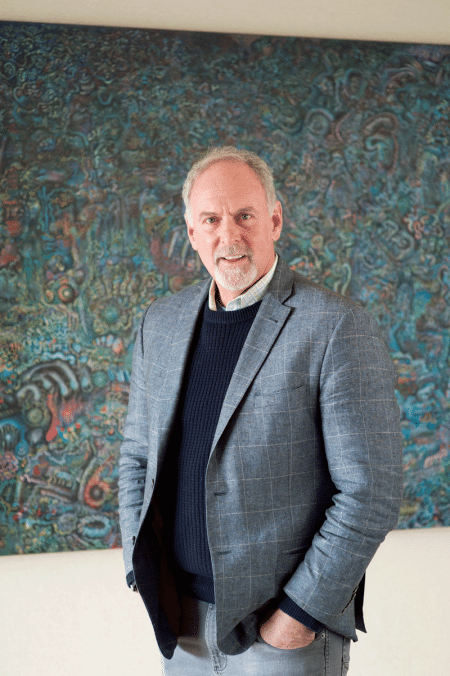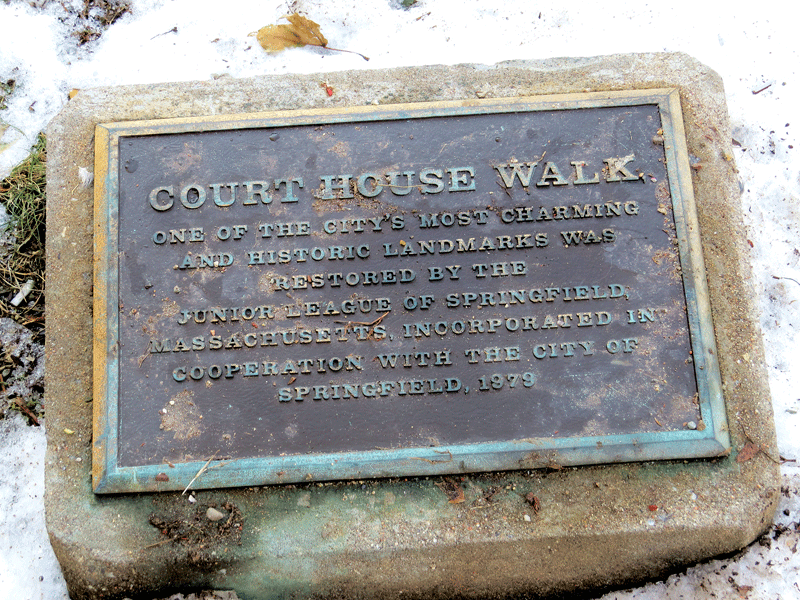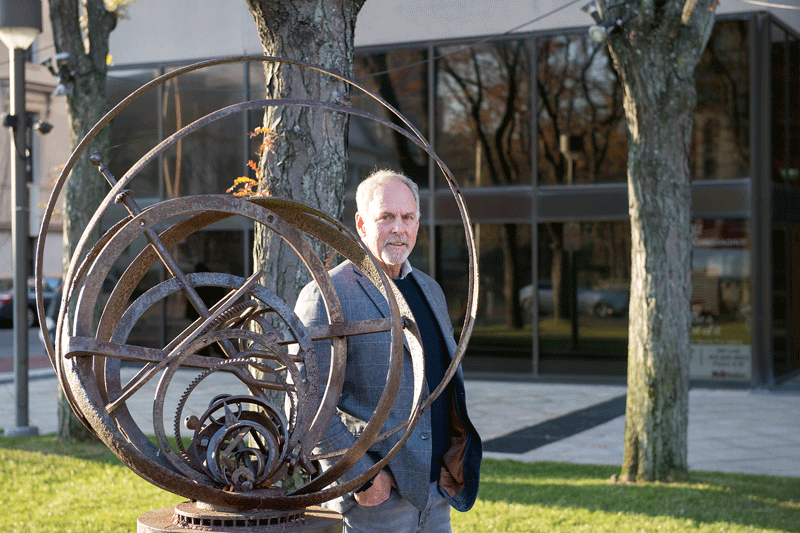Evan Plotkin: President of NAI Plotkin
Evan Plotkin Works to Fill in the Canvas Known as Springfield
 The small bronze plaque is starting to show its age.
The small bronze plaque is starting to show its age.
Fastened to a rectangular stone near the former Court Square Hotel and the old Hampden County Courthouse, it proudly celebrates work done to clean up a walkway that connects Court Square with State Street. It reads:
COURT HOUSE WALK, one of the city’s most charming and historic landmarks, was restored by the Junior League of Springfield Massachusetts Incorporated in cooperation with the City of Springfield, 1979.
Evan Plotkin, president of NAI Plotkin, can’t really see this plaque from the south-facing window in his office on the 14th floor of 1350 Main St. (although he can see quite a bit, as will be noted later). But he references it when he can because, in many ways, it, like similar milestones around the city, presents a perfect segue into a discussion about what drives his efforts to revitalize Springfield, especially through the arts and restoration and celebration of existing treasures ranging from parks and fountains to the Connecticut River.
“You can almost imagine the ceremony there, with media standing by and the public officials, and everyone making a proclamation and galvanizing it on a plaque on the ground,” he told BusinessWest as he looked out his window and gestured toward the walkway. “There are a lot of plaques like that around the city, and they all say, in essence, ‘this is a commitment that we made, and we put in bronze, presumably so it would last longer than we are going to last so that future generations will know that at one time we had this vision of doing something.’
“When I first saw that plaque, and saw there were dead rats along that sidewalk and all the lights were out, I said, ‘this is not the vision that they had,’” Plotkin went on. “They had a vision of connecting this beautiful park to another very important commercial district with something special.”
There are, as he noted, a great many stories like that walkway scattered across downtown Springfield and beyond. Stearns Square is one of them. Pynchon Park, the elaborate, much-heralded space built in the late ’70s to connect the Quadrangle with the central business district and abandoned soon after it opened, is another. There’s also Riverfront Park, the Apremont Triangle area, and many more.
There are plaques at some of those sites, but there were gatherings of people and celebrations at all of them, said Plotkin, who has committed his adult life to restoring … well, something approximating what it was that people were celebrating when they gathered, made speeches, and maybe cut a ribbon.
In the case of that walkway, for example, Plotkin made sure that it was part of City Mosaic, what amounts to a giant mural on the Court Square property that he helped bring to fruition, one that features the likenesses of dozens of celebrities, from the Beatles to Louis Armstrong. Judy Garland, Muhammad Ali, Elvis Presley, and John Lennon are among those who can be seen on the walkway portion of the mural.
There are many other examples of Plotkin’s work to re-energize and enliven Springfield — from his hard work to revitalize the Springfield Jazz & Roots Festival to his efforts to lead the Art & Soles public art project that placed colorful sneakers around downtown, to his success in turning 1350 Main into a kind of art gallery.
And there are many things, beyond those aforementioned plaques, inspiring Plotkin as he goes about this wide-ranging work. Part of it is what he fondly remembers from his youth, a half-century ago, when he, like countless others who grew up near the City of Homes, would get on a bus on a Saturday morning, travel to downtown Springfield, and spend literally all day there — at Johnson’s Bookstore, Herman’s World of Sporting Goods, Forbes & Wallace, the movie theaters, Friendly’s, and countless other destinations.
Another part of it is what he’s seen during his many trips to Europe, where squares and plazas in Rome, Madrid, Venice, Amsterdam, and other cultural centers are filled, not just with tourists, but locals.
Another part of it is recognition not of what Springfield was — 50 years ago or 150 years ago, for that matter — but what it could be. Especially at a time when we are told urban living is making a comeback, that Millennials want to live in places where they may not have to drive, that downtowns are hot again.
But what probably drives him most is the fact that not all downtowns are hot, and not all cities are attracting Millennials and retiring Baby Boomers alike.
No, only those cities that can create an attractive mix of things to do, places to live, cultural amenities, and a sense of safety and comfort are making their way into that category.
Plotkin has made what amounts to a second career out of efforts to make Springfield one of those cities. And for his tireless — and we mean tireless — efforts, he is certainly worthy of the designation Difference Maker.
Art of the Matter
Getting back to what Plotkin can see out his windows … there’s plenty, as we noted. There’s the river, the South End and the casino rising there, and, yes, Court Square, in which there is a slightly larger plaque he can actually see and took the opportunity to point out.
It commemorates the Parsons Tavern, which stood on that site. It was there that George Washington was “entertained” — it doesn’t say anything about him sleeping there — on June 30, 1775 while traveling on horseback from Philadelphia to Cambridge to take command of the American forces. And he stopped there again 14 years later, this time as president of the young country, while traveling by coach through the New England states.
“There are neat plaques and monuments like that all over the city, and most people don’t know they’re there,” said Plotkin, who pointed out another — the lion’s-head fountain on the east side of the square that was restored several years ago.
But Plotkin certainly doesn’t restrict his interests and his activity to what he can see out the window. Indeed, he walks the city pretty much on a daily basis, usually with his dog, George, at his side. While he’s walking, he’s always taking mental notes, he said, and thinking about what was, in some cases, and about what can be in all cases.
A real-estate broker and manager by trade, Plotkin is also an artist. The area once occupied by Santander Bank’s lobby at 1350 Main St., which Plotkin co-owns, has many of his works on display. They include some sculptures and a large collection of photos of images (mostly faces) he created on his plate by arranging various foods just so. Really.
“I call it food art, or face food — it’s a little goofy,” he told BusinessWest. “It’s not really a genre, it’s just something I do.”
So, in many respects, Plotkin the artist sees Springfield as his canvas, one that he is filling in through his various endeavors. Looked at another way, though — and this is probably the more accurate description — Springfield itself is a work of art in need of restoration work, and Plotkin, the artist but also the community activist, Springfield champion, and sometimes (often?) pain in the neck to those in City Hall, is heavily involved in that restoration work.
Overall, while his artistic portfolio is mostly about positioning meats and vegetables, his work with and on behalf of the city amounts to what he calls “activating space,” with ‘activating’ taking many forms.
They include everything from revitalizing spaces or facilities — such as the fountain at Stearns Square, which has been dismantled for repairs — to bringing vibrancy to a given location, such as efforts he’s led to bring the Springfield Jazz & Roots festival to Court Square (more on that later).
Plotkin’s not sure when he started doing all this, but as he looks back, he believes he’s pretty much always been involved in such efforts.
Speaking of looking back, Plotkin did a lot of it as he talked with BusinessWest, recalling, for example, those bus trips downtown, visits to the family business’s offices on Dwight Street, and walks with his father and grandfather through a much different downtown Springfield.
“All the shop owners, whether they were a furrier or a hatter or a print shop … all these different store owners would be out talking with people, and my grandfather knew every one of them,” he remembered. “It seemed like a really great community of small businesses, family businesses, and I think this is something that’s been lost in the downtown.”
The rise of the automobile and the construction of roads like I-91, I-291, and I-391 played a big part in this transformation, he went on, adding that, as people and businesses left for the suburbs and malls, downtown lost its vibrancy as well as its appeal.
But in some cities, he said, a reversal of that transformation is taking place, with people moving back downtown and cities putting more emphasis on infrastructure for pedestrians and bicycles and dedicating less space to surface parking lots, for example.
Can the same happen in Springfield? Plotkin offered what amounts to a ‘yes, but…’ And by that, he meant that there is still considerable work to do.
Past Is Prologue
Plotkin knows better than anyone that there is no turning back the clock to 1969, to those bus trips to downtown and on to Johnson’s bookstore, stops at the typewriter repair shop or record store while walking around.
But there can be a return to the type of vibrancy that existed then, he went on, adding that Springfield can be one of those cities to capitalize on the apparent surge in urban living and the return of the downtown.

When helping to bringing City Mosaic to reality, Evan Plotkin made sure Court House Walk was included in the project.
Much will have to go right, he admits, and the city will have to somehow answer that perplexing urban version of the chicken-or-egg question, which goes something like: ‘which comes first — the people or the restaurants, coffee shops, retail, and jobs?’ The theory goes that you can’t have one without the other.
Plotkin believes the city needs to be focused on both sides of the equation at the same time, and especially the part about getting people here. All those other things will follow, he said.
But to get people here, the city must be more livable, he said, meaning it must be safe and vibrant, have places for people to live, offer culture, and provide an infrastructure that, as noted, is far more pedestrian- and bicycle-friendly.
And he’s focused on all of the above through his work to activate spaces.
With that, he recalled his most recent trip to Europe and, more specifically, to Amsterdam and a plaza called Dam Square.
“It’s mobbed with people, it’s the epicenter of the city historically, it’s beautiful visually, and it’s the heart of the city; that’s where people to go to mingle and mix and shop and entertain themselves,” he said. “To draw a comparison to Court Square, I’ve looked on that as being one of those great public spaces, and the frustrating thing for me throughout my time in Springfield is that I see these public spaces and their potential — which is underutilized.
“And it frustrates me to no end,” he went on. “We have such incredibly important public spaces that have been dormant for some time. When you go to a place like Dam Square or Plaza Mayor in Madrid or other places like that, and see the activity that’s happening in those places, which isn’t contrived, it happens every day, you imagine the possibilities, but you also get frustrated.”
Perhaps the most glaring example of facilities being underutilized is Pynchon Park, he noted, adding that it had a very short life as a park before it was essentially locked down and abandoned amid safety concerns and other considerations.
“There was no plan for Pynchon Park,” said Plotkin with noticeable exacerbation in his voice. “I know from being in real estate that if you build something, that’s not the end of the game; you have to maintain that property. You have to think about security, infrastructure, maintenance, and keeping it clean so it is serviceable for the purpose for which it was intended.”
But, in a twist, Pynchon Park, which has long been a poster child for neglect and underutilization of resources, may soon be one of the more stunning examples of what Plotkin called a “sea change” taking place in Springfield.
Indeed, the park is slated for a $3.5 million facelift (funded by the MassWorks Infrastructure Program) that will include, ironically, a decidedly European form of conveyance, a funicular, to transport people from Dwight Street to Chestnut Street and the Quadrangle.
Other examples include Stearns Square and its fountain, Duryea Way, and Riverfront Park, also scheduled for a major renovation.
Accomplishments of Note
The jazz festival is part of this sea change, he went on, adding that his work to bring that event downtown and continue the tradition after it was discontinued for a few years is exemplary of his broader efforts to make downtown a gathering place and not just a Monday-through-Friday, 9-to-5 place.
Plotkin said his involvement with the festival began in 2005 when he served as a volunteer for what was known then as the Hoop City Jazz Festival, staged in the quad on the STCC campus and later at Riverfront Park. At first, he worked with founder John Osborne and other members of a committee to create a slate of performers, and later got involved with the fund-raising side of the venture.
“I really loved the idea, but I was troubled with the event not being in the downtown, and I said to John, ‘I don’t really want to do this anymore unless we move it to the heart of downtown in Court Square,’” Plotkin recalled, adding that, when he convinced Osborne and the mayor to make that move, the event, and the city, were energized by it.
When Osborne fell ill at the start of this decade and the event fell into limbo, Plotkin was instrumental in bringing it into a new era with a new name, the Springfield Jazz & Roots Festival.
Now entering its sixth year, the festival is doing what Plotkin envisioned it would — it is using music to bring a diverse audience of people to celebrate music and energize the city and its downtown.
“When I look out the audience and see the faces and the different demographic groups that attend, and the overwhelming joy that people have congregating in that park and listening to music … it’s kind of like a Woodstock,” he explained. “It’s like a love fest.
“Music breaks boundaries, it breaks barriers, and it brings people together,” he went on. “I know that’s cliché of me to say, but it just … seems to work.”
Many other initiatives that Plotkin has led have worked as well. That list includes Art & Soles, which placed dozens of five-foot sneakers around the downtown area and beyond; City Mosaic; the conversion of the ninth floor of 1350 Main St. into what’s known as Studio 9, a community gathering space; use of the front lobby — and now other spaces — at 1350 Main for use as gallery space; work in partnership with artist James Kitchen to bring many of his metal sculptures to the downtown area; and much more.
As he reflected more on Springfield, its downtown, and what it will take to make the city a destination, Plotkin talked about building blocks and how his work and that of others represents putting such blocks on top of one another to build something substantial — and lasting.
“I think one of the next big things that needs to happen is to focus on how we can redevelop some of the class B and C office space into market-rate or affordable housing so we can attract people down there,” he said of just one the ‘blocks,’ the all-important housing component. “But that’s only going to happen when we restore our parks, reconnect the river to the city, and do something about the lack of attention given to those aspects of building a vibrant downtown.
“If you start making moves in these directions, and if you start restoring your public spaces, these efforts will all lead to that general sense of well-being that people have,” he went on, “and the positive feelings that people have about being here and living here.”
Walking the Walk
It’s safe to say few people have ever traveled down Court House Walk. And even fewer have noticed the small plaque commemorating its restoration four decades ago or taken the time to read it.
Evan Plotkin has, and while reading, he allowed his mind to drift back to the day people gathered at that spot, gave speeches, and cut a ribbon.
Although he recognizes that the walkway is a comparatively modest example of a space that needs to be activated, of something once celebrated that has since been forgotten, it is nonetheless symbolic of everything he has worked for and continues to work for.
It’s not about the past and bringing back good old days, but about the future, and creating a Springfield that people will want to live in and work in and visit to take in a jazz festival.
Like art, and, yes, even food art, this work has become a passion for Plotkin, and it has made him a true Difference Maker.
George O’Brien can be reached at [email protected]









